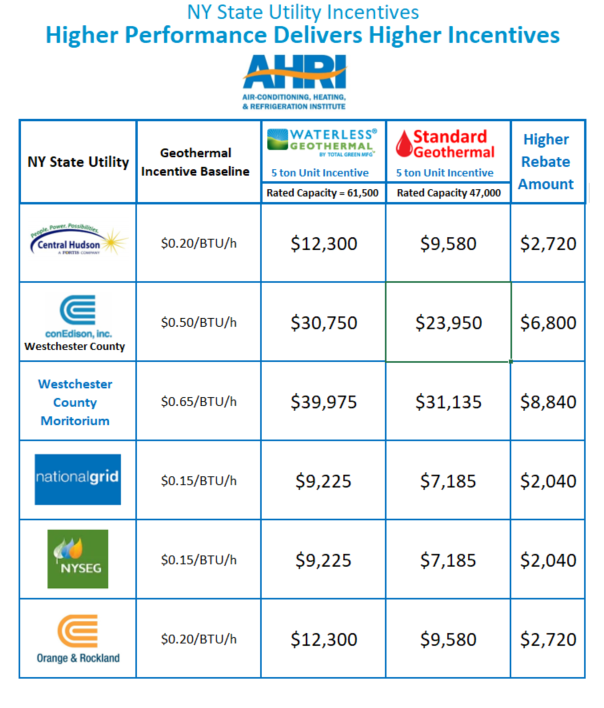A Guide to Federal Tax Credits for Geothermal Systems in New York
As the desire to reduce energy bills continue to grow, along with the recent and upcoming bans on natural gas, homeowners in New York are increasingly turning to geothermal heating and cooling systems. Not only do these systems provide a reliable and eco-friendly way to regulate indoor temperatures, but they can also lead to significant savings. What’s even more appealing is that, in addition to lower energy costs, homeowners can take advantage of federal tax credits and rebates from the utility company to further sweeten the deal.
Understanding the Federal Tax Credits
The federal government offers homeowners a financial incentive to adopt clean and renewable energy sources, including geothermal systems. This incentive comes in the form of the Residential Renewable Energy Tax Credit, which can be a substantial benefit for those who invest in geothermal technology.
Determining Eligibility
Before you can start enjoying the tax credits, it’s essential to ensure you meet the eligibility criteria. Generally, to qualify:
- Your System Must Be Installed: Tax credits are only available for systems that have been placed in service. This means your geothermal system must be fully installed and operational.
- Geothermal Must Be the Sole or Main Source: To qualify, your geothermal system should be the primary heating and cooling source for your home.
- EER and COP Requirements: Your geothermal heat pump should meet Energy Efficiency Ratio (EER) and Coefficient of Performance (COP) requirements, which are energy efficiency standards. Most modern geothermal systems meet these criteria. Energy Star has defined the geothermal efficiency criteria required to be eligible for a federal tax credit.
Calculating the Tax Credit
The federal government provides a tax credit equal to a percentage of your qualified geothermal system expenditures. Currently, they can range between 22-30%, plus $1000s in additional incentives from certain utility providers through the Clean Heat Program. The credit is equal to 25% of your qualified geothermal energy system equipment expenditures and is limited to $5,000.
For example, Central Hudson offers a rebate of $0.20 per BTUH (British Thermal Unit per Hour), which can amount to substantial savings, such as $12,300 for a 5-ton heat pump system. Con Edison provides a generous rebate of $20,000 per project, further enhancing your potential savings.
If you’re served by National Grid or NYSEG / RGE, you can take advantage of rebates amounting to $0.15 per BTUH, potentially saving you $9225. Orange & Rockland also offers a rebate program at $0.20 per BTUH, which can result in savings of $12300.
Moreover, PSEG Long Island provides rebates based on the COP (Coefficient of Performance) and EER (Energy Efficiency Ratio) of your geothermal system. For instance, homeowners installing a typical 4-ton system (48,000 BTU) in a 2,500 sq ft home can receive an impressive rebate up to $8,383 for a new system. It’s important to note that these rebates are typically capped at 70% of the project cost.
To take advantage of these rebates, you’ll need to follow a pre-inspection and post-inspection process at your home. By leveraging these rebate programs, you not only make a smart investment in energy-efficient heating and cooling but also enjoy considerable cost savings as a responsible homeowner in New York.
Installing a Waterless Geothermal design offers you a significant advantage due to a higher BTU rating when comparing heating output capacities to traditional water-based designs. There is a significant difference in the 3rd part verified capacities. Some home owners can see as much as $2,720 more when installing a direct exchange geothermal system.

Claiming the Credit
To claim your New York state tax credit, you’ll need to file IRS Form IT-267 along with your annual federal tax return. Ensure you keep detailed records of your geothermal system purchase and installation, including phots, invoices and receipts, as you may need to provide documentation to support your claim. For utility incentives, check with your local provider. Claiming the tax credit through the IRS is a straightforward process. All you need to do is complete Form 5695 when you file your taxes.
Consult a Tax Professional
While geothermal tax credits can be a fantastic financial benefit, navigating the tax code can be complex. It’s advisable to consult a tax professional or CPA who is well-versed in energy-related tax incentives to ensure you receive the full benefit you’re entitled to.
Stay Updated
Tax laws can change, and incentive programs may evolve over time. It’s essential to stay updated with the latest information regarding federal and state tax credits for geothermal systems. Government websites, local utility providers, and tax professionals can be excellent sources of up-to-date information. A good source is dsireusa.org.
In conclusion, if you’re a homeowner in New York looking to make your home more energy-efficient and environmentally friendly, installing a direct exchange geothermal heating and cooling system can be an excellent choice. Coupled with federal tax credits and potential state incentives, it’s an investment that not only benefits your comfort but also your financial well-being and the planet.
Get in touch with us now to explore how you can maximize your savings while enjoying the comfort, savings, and eco-friendliness of geothermal technology. It’s time to make your home greener and your wallet happier.





